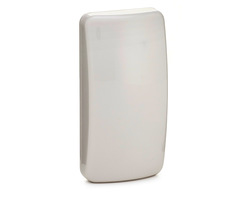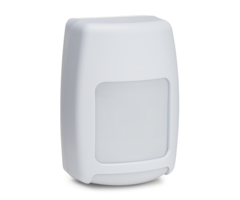What Loop Number Does My Honeywell 5800 Series Wireless Device Use?
The loop number used with a Honeywell 5800 Series wireless sensor depends on the type of device being used. For devices that support multiple uses, which features are being used also matters. Below is a list of commonly used 5800 Series wireless devices and all of their applicable loops.
5816 Wireless Door/Window Transmitter
Loop 1 = Normally Closed wired input.
Loop 2 = Magnet and internal reed switch.
 5821 Wireless Temperature & Water Sensor
5821 Wireless Temperature & Water Sensor
Loop 1 = Cold Temperature Sensing - Internal Sensor.
Loop 2 = Hot or Warm Temp Sensing - Internal Sensor.
Loop 2 = Freeze or Refrigerator Sensing - T280R required
Loop 3 = Flood Sensing FP280 or 470PB required.
Note: The function of each loop is determined, in part, on how the dip switches are set. Only one remote probe can be used, so you can either use the T280R for Freeze or Cold temp sensing, or you can use the FP280 or the 470PB for flood sensing. However, you cannot use both. Obviously, loop 2 can be Hot/Warm or Freeze/Cold, but not both. See the installation instructions for full details.
 5800PIR-RES Wireless PIR Motion Sensor
5800PIR-RES Wireless PIR Motion Sensor
Loop 1 = Motion Alarm input, up to 80 pound pet immunity.
 5853 Wireless Glass Break Detector
5853 Wireless Glass Break Detector
Loop 1 = Glass Break Alarm input.
 5808W3 Wireless Smoke/Heat/Cold Temp Detector
5808W3 Wireless Smoke/Heat/Cold Temp Detector
Loop 1 = Smoke and Heat Alarm input
Loop 2 = Maintenance input, if the panel doesn't offer "Smart Contact" support. Sent with check-in signal.
Loop 3 = Cold Temp (below 41 degrees Fahrenheit). Sent with check-in signal.
 5800PIR Wireless Motion/Cold Temp Sensor
5800PIR Wireless Motion/Cold Temp Sensor
Loop 1 = Motion Alarm Input. Up to 80 lb pet immunity
Loop 2 = Motion Alarm Input. Higher Sensitivity, no pet immunity
Loop 3 = Low Temp input (below 45 degrees Fahrenheit for greater than 10 - 30 minutes)
 5800PIR-COM Wireless Commercial Motion/Cold Temp Sensor
5800PIR-COM Wireless Commercial Motion/Cold Temp Sensor
Loop 1 = Motion Alarm Input. Low Sensitivity (no pet immunity).
Loop 2 = Motion Alarm Input. High Sensitivity.
Loop 3 = Low Temp Input (below 45 degrees Fahrenheit for greater than 10 - 30 minutes).
 5800COMBO Wireless Smoke/Heat and CO Detector
5800COMBO Wireless Smoke/Heat and CO Detector
Serial Number 1, Loop 1 = Smoke and Heat Alarm Input.
Serial Number 1, Loop 2 = Maintenance (for panels that don't support the "Smart Contact" feature).
Serial Number 1, Loop 3 = Cold Temp (below 41 degrees Fahrenheit).
Serial Number 2, Loop 1 = Carbon Monoxide Alarm Input
Serial Number 2, Loop 2 = CO Detector End of Life alert.
Note: Serial number 2 is one digit higher than serial number 1. If the last digit of serial number 1 is a 9, then serial number 2 will be 1 digit higher than the last 2 digits of serial number 1. For example, if serial number 1 ends in 39, then serial number 2 will end in 40. See the Installation Instructions for full details.
 5815 Wireless Door/Window Transmitter
5815 Wireless Door/Window Transmitter
Loop 1 = Normally Closed Wired Input.
Loop 2 = Magnet and Reed Switch. There are 2 reed switches available to allow for multiple placement options, but only one can be used.
 5800RP Wireless Repeater
5800RP Wireless Repeater
Dip switch 2 OFF, Loop 1 = Supervision for Check-in, low battery, AC loss and RF Jam.
Dip switch 2 ON, Serial Number 1, Loop 1 = Low Battery and Check-in.
Serial Number 2, Loop 1 = Tamper Supervision.
Serial Number 2, Loop 2 = AC Loss Supervision.
Serial Number 2, Loop 3 = RF Jam.
Programming the 5800RP for supervision is not required, but it is recommended. When Dip switch 2 is on, the 2nd serial number is enabled. It will be one digit higher than the serial number printed on the device. See the Installation Instructions for full details.
 5800WAVE Wireless Indoor Siren
5800WAVE Wireless Indoor Siren
Loop 1 = Supervision for RF Check-in, Low Battery, AC Loss and Tamper (if the magnet is installed next to the siren).
Much like the 5800PR, supervision is not required, but it is recommended. See the Installation Instructions for full details.
Did you find this answer useful?
We offer alarm monitoring as low as $10 / month
Click Here to Learn MoreRelated Products



Related Categories
- Wireless Alarm Control Panels
- DIY Wireless Security Systems
- Transmitters
- Wireless Glass Break Detectors
- Wireless Motion Detecting Sensors
- Wireless Environmental Sensors
- Wireless Smoke Detectors
- Wireless Garage Door Alarm Sensors
- Wireless Door Sensors and Window Alarm Sensors
- Wireless Heat Detectors
- Wireless Alarm Sirens
- Answered
- Answered By
- Julia Ross









